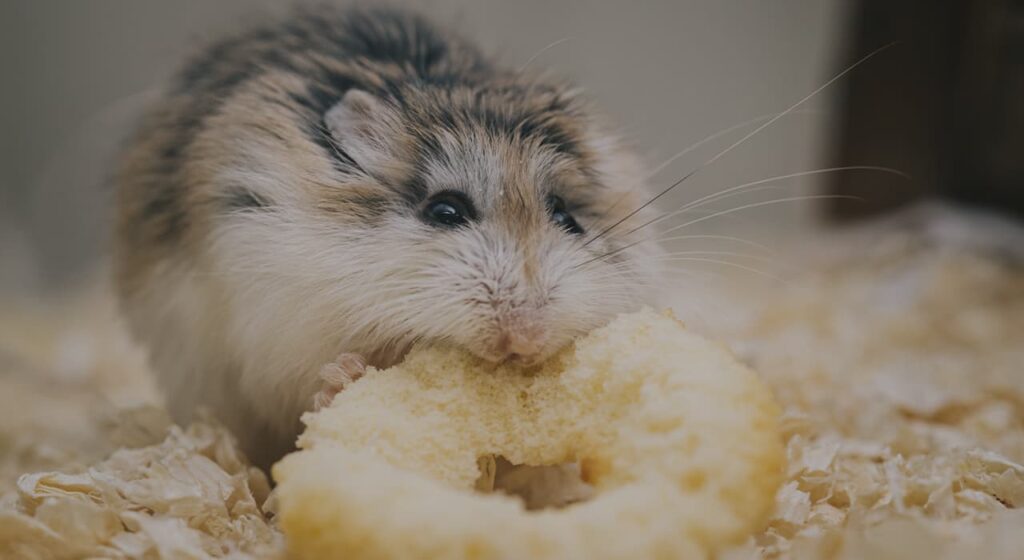Appearance
The Jungar hamster has a pointed muzzle, small ears, and its finger tubercles are hidden under the thick hair that covers the soles of its paws. The maximum body length of the representative is ten centimeters. The abdomen of the rodent is pale and its back has an ochre gray or brownish gray coloration. The paws of the Dzungarian hamster are white, the ears are white on the inside, and a narrow black stripe runs along its spine. In summer, individuals have a grayish color predominantly, and in winter its coat becomes white with a silvery-white tint. Specimens show particular activity at night. The life expectancy of the Dzungarian hamster is three years.
Nutrition of the Dzungarian hamster in the home.
At home, Jungar hamsters can be fed all sorts of foods that are easy to buy or make. Jungar hamsters gladly eat cabbage, cucumbers, carrots and other vegetables, they like to eat different fruits: grapes, apples and other vitamin delicacies. They gladly eat dried fruits: raisins, dried apples, etc., and do not mind eating sunflower seeds.
If you decide to keep a jungarican at home, be very attentive to its diet: do not give it sweet, salty food and food with various spices. Make sure that your pet’s diet does not include a product saturated with monosaccharides. These are all precautions related to hamsters’ predisposition to diabetes.
Give your pet more domestic fruits, except citrus fruits, raw and cooked vegetables.
Professional feeding arrangements for the Dungarian hamster
Hamster breeders use for food that is designed for hamsters, rats and mice. This is a balanced diet that allows for the replenishment of the body of the Dungar hamster with the necessary vitamins, minerals, and nutrients.
Hamster food should include about 24% protein, about 5% fat and about 61% carbohydrates. If a hamster weighs 100 grams, it only needs 7 grams of this food.
Hamster breeders recommend enriching hamster food with fruits, vegetables, lettuce, dandelion leaves and other herbs.
Strangely enough, hamsters like to eat raw meat. However, you should not abuse this product. Give meat to the hamster not more than twice a week.
Keeping a Dungar hamster
To keep the Jungar hamster at home, the most ideal variant is a cage without a galvanized frame of 30x50cm.
The cage must be equipped with:
- A bedding, which can be fine sand or pressed sawdust that absorbs moisture well and is excellent at absorbing odors. Do not use absorbent cotton, napkins, rags or newspapers of any kind as a bedding.
- A special litter box for small rodents with absorbent material used as a filler.
- A crawlspace, which can be roots, branches and tubes.
- a house which must be attached to the wall of the cage.
- A wheel with cross bars and a bottom without bars, tailored for their size.
- A water bowl with a capacity of fifty milliliters, which must be changed daily.
- Feeder with a width of up to ten centimeters, which should be selected taking into account the size of the fluffy pet.
A delicate subject. Hamster breeding.
Joint keeping of male and female jungar hamsters
Experienced hamster breeders recommend keeping female and male hamsters in separate cages and uniting the “family” only for the mating period. It is done to avoid conflicts and fighting for territory. But, sometimes, there are cases of hamster family living together all their lives. It is impossible to predict how events will unfold in the cage, so it is better to rely on your intuition, and then act according to the situation.
After placing a male and female together, monitor their behavior. It is desirable to keep a pair of jungariks from an early age, so they can normally exist together. Adults that lived separately require additional precautions. At first, you should settle them next to each other in a cage with a partition so that the hamsters get used to each other’s smell. After some time, the partition can be removed and the cage placed in a place with bright light. This will provoke them to hide together in the dark, and they will snuggle up to each other, which will speed up the process of habituation.
